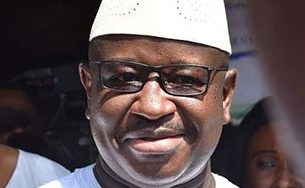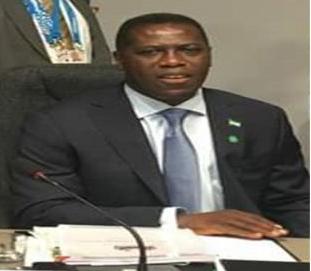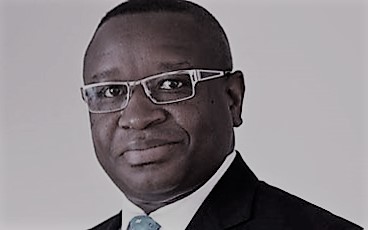Sierra Leone: Be Rwanda! Don’t Be “Rwanda”!
While you get intrigued, or, perplexed, by the title of this piece, let me swing to what has prodded me to write another of my thought-provoking pieces: Charles Margai. He is my maternal uncle, as I have written several times.
Nonetheless, my journalistic integrity, and Yoga discipline (at 55, I can do most Yoga asanas, which includes headstands, backbends, etc.) ensconces me on the spiritual pedestal of harboring thoughts of “non-attachment” (to country; region, tribe, family, etc.).
Charles Margai appears to be on the political rack again. Or, basking in the limelight of what he thrives on: controversy; stirring the hornet’s nest. There have been several thoughtful newspaper pieces written about his recent verbal face-off with the quintessential APC spin doctor, APC Spokesman (and communications/broadcasting minister), Alhaji I.B. Kargbo. One of them was by the 27 year old Pa John Baimba Sesay. Pa Baimba reminded the APC that Charles Margai’s appeal (or, was it instruction?) to his PMDC partisans to support the APC in the presidential run-off elections in 2007 was the clincher for the APC to win the presidency. (With votes cast for the APC in Bonthe District spiking to 20,000, from the 2,000 votes during the first round).
There was one poignant reason Charles Margai gave for his decision to pitch tent with the APC against the SLPP – a party he almost literally resuscitated in 1991 when most other SLPP leaders would not dare publicly identify with the SLPP even as the APC One Party era ebbed; a party he served as cabinet minster between 1998 and 2002; a party of his fathers (his uncle, Sir. Milton Margai was the first SLPP Prime Minister, and his biological father, Sir. Albert Margai, was the second SLPP Prime Minister in the 1960s): to bridge the tribal divide; to stimulate more tribal harmony. Is there a “tribal divide” that is so worrisome in Sierra Leone that should get me to draw images of “Rwanda” as a warning?
Yes. There is. Sociologically, and economically, there is hardly any “tribal divide” – especially among the majority youth population in Freetown who mingle with each other oblivious of tribal coloration.
Politically, our tribal divide is rotten; stinking; palpable! The Temne versus Mende tribal fires are normally stoked to irrational murderous frenzy by politicians when they aim to grab power, and/or sustain themselves in power during general elections.
In all free and fair elections in Sierra Leone since 1957, there would be a rigid political divide, as John Baimba Sesay wrote last week, with the SLPP getting almost 100% of votes cast in the Mende-speaking South-East; and the APC (or, political parties like the UNPP, PDP, headed by Temne-speaking Northerners) securing almost 100% of the votes in the Temne-speaking North and Temne-dominated Western Area of Freetown. I am sure that hardly any one would risk his reputation to dispute this fact: the first APC coerced the Mende-speaking people of the South East and legalize a One Party state in the 1970s. In 1991, when Temne-man, retired army Corporal Foday Sankoh, fluent in the Mende language, led his Revolutionary United Front (RUF) rebels to invade Sierra Leone through the Mende-speaking territory of Kailahun District, his ruse to stimulate recruitment to his rebel force was: they were going to get rid of the APC government. The ‘seeds’ of political coercion sown in the 1970s were made to germinate in 1991. Now, let me draw the parallel with “Rwanda”.
‘Rwanda’ in global consciousness invokes images of one of the most horrific scenarios in human history – the 1994 genocide by Hutu extremists of almost one million Tutsi minority, AND, Hutu moderates, within just a hundred day period. Let us go down history lane.
The Europeans who moved to control the tiny landlocked Central Africa mountainous nation of Rwanda as far back as the 18th Century were quite smitten with the Tutsi, whom they saw as definitely too fine to be ‘negroes’. Read this racially constructed description of the Tutsi found in the 1925 Belgian Colonial Report: ‘The (Tutsi) of good race has nothing of the Negro, apart from his color. He is usually very tall … (the Tutsi) are gifted with a vivacious intelligence… display a refinement of feelings which is rare among primitive people. He is a natural born leader, capable of extreme self-control and of calculated goodwill…’
It was under Belgian rule that ethnic construction reached new levels with the introduction of schools for Tutsi children. Tutsis were given administrative positions from which Hutus were excluded. Tutsis and Hutus themselves internalized the identities assigned to them by the colonizers. Hutus were told by everyone that they were inferiors who deserved their fate and came to believe it.
To cut this long history short, the Hutu who had been suppressed for over a century took over power in Rwanda. During the early 1990’s, the government of Rwanda carried out a program of ethnic division, raising hatred against the Tutsi minority in the country. The catalyst for the genocide to be unleashed – April 6, 1994: President Juvenal Habyarimana was killed in a plane crash. Tutsi extremists were accused of being responsible. The Rwandan Armed Forces and Hutu militia immediately started to systematically murder Tutsis and moderate Hutu politicians. Ordinary Hutu civilians would move from house to house butchering Tutsis with machetes – about a million Tutsis!! Aha!!! ‘That won’t happen here in Sierra Leone’, I can hear you say, ‘Not with so many intermarriages between the majority Temnes and majority Mende, and easy ethnic intermingling’. There were a lot of intermarriages between the Hutus and Tutsis too, right up to the time of the genocide. That ‘moderate Hutus’ were also massacred showed that not all the Hutus agreed to take part in the mass killings of Tutsis. It is a ‘Central Africa thing’? No, sir!
I had been in Liberia for over ten years at the time Charles Taylor ignited his war against Liberian President Samuel Kanyan Doe on December 24, 1989. From 1985 onwards, Doe’s Krahn minority tribe from Grand Gedeh County had been engaged in spasmodic ‘ethnic cleansing’ against their perceived arch enemies, the Gio-Mano of Nimba County. As Taylor’s rag tag army advanced towards the capital city of Monrovia from Nimba County in 1990, Doe would raid Gio-Mano enclaves in Monrovia, capture some men, chopped off their heads, and display them on roadsides; telephoning THE DAILY OBSERVER newspaper, for it to be featured on their front pages. Living in Monrovia then, I would say with revulsion, and pride, ‘That would never happen in Sierra Leone!’ Indeed, Foday Sankoh’s rebel war was not patterned along ethnic lines, but, the nauseous atrocities of our rebel war – the indiscriminate amputation of all ethnic groups; the disemboweling of pregnant women; the senseless arson of public and private buildings – could be classified as worse off than Liberia’s. Great Evil that flowers in one society (like Adolf Hitler’s Nazi Holocaust on Jews in the mid-20th Century) when it would be replicated in other societies (like Pol Pot’s genocide on 2 million Cambodians over 25 years of age in the 1970s; China’s Moa Zedong mass killing of about 40 million Chinese during the Great Leap Forward and Cultural Revolution eras in the 20th Century) is not always done with exactitude. My point: we could be sowing the seeds of a “Rwanda” in Sierra Leone (with the crescendo of protests over intense tribal polarization over the past year; what Charles Margai lampooned as ‘Northernization’); and what Charles Margai could have sought to do in 2007 was to prevent the seeds of “Rwanda” from being nurtured in Sierra Leone.
The ethnic jingoist among the political class should read Rwandan history, and draw lessons for it. The Hutus were for almost a century the underclass. They were not only politically emasculated, educationally disadvantaged, but, psychologically made to feel inferior. That they could become the ‘over-class’ and unleash genocide on their Tutsi overlords should get us to reflect on the Creole saying, ‘kaka long tay e mus cut’. Instead of going through the route of the Rwandan genocide before we are nudged to our senses, it is best if, after our own cataclysmic rebel war, go the way Rwanda is going today in accelerated development. The APC ought to call Charles Margai in close door meetings, and deliberate on what caused his outburst. The APC should be more inclusive in distribution of senior government positions. The APC should calculatedly try to harness the rare quality manpower of our country, irrespective of tribe or region. Let Sierra Leone NOT be the genocidal Rwanda but the un-genocidal Rwanda.
Rwandatel SA in Kagali this year launched Super Fast Internet Speeds with SEACOM’s Submarine Fibre Optic Cable. This means that Rwandatel’s 2G, 3G and ADSL customers can now access uninterrupted high speed connectivity with SEACOM band-width. From a commercial angle, e-commerce will take on added significance.
Rwanda has just finished a pilot U.S.-originated One Laptop per Child (OLPC) program. The government of Rwanda plans to buy and distribute another 100,000 computers – at $181 each – to children by next June next year. A year after that, it wants to distribute laptops to half of Rwanda’s 2.5 million schoolchildren – that is OVER ONE MILLION LAP TOP COMPUTERS.
No nation as poor as Rwanda has embraced OLPC founder Nicholas Negroponte’s idea so fully. “What is different about Rwanda is (President)) Paul Kagame’s long-standing belief in us and us in him. We will walk to the end of the earth to help him and Rwanda,” Negroponte told TIME in an e-mail interview.
One of the leading columnists in Nigeria, Reuben Abati, wrote this (in this web address: http://www.nairaland.com/nigeria/topic-237059.0.htmlThe road to Kigali) about Rwanda recently: “I have just returned from Rwanda….Fourteen years ago, Rwanda…was a killing field ….(Today) there are no potholes on the roads, electricity supply is taken for granted, 24/7 all year-round, there is pipe borne water. The whole city is littered with trees and in both poor and rich neighbourhoods, there is a sense of human dignity.The use of polythene nylon is forbidden in Rwanda, and so there are no pure water sachets littering the streets. The city is so squeaky clean it is embarrassing…” A.O. Kamara, the deputy director for administration in the National Revenue Authority (NRA) who was one of a team of five NRA staff who returned from a Study Tour in Rwanda just last month also expressed his being shamed by the squeaky cleanliness of Kigali when compared to the sordid filthiness of Freetown.
Now, you have seen the logic in my title, “….Be Rwanda. Don’t be “Rwanda”. With Britain’s former Prime Minister leading the PR onslaught to rebrand Sierra Leone, and our President Koroma recently in the UN burnishing our image with his ‘Agenda for Change’ being marketed internationally, let us emulate the determined developmental surge of Rwanda, not allow our ethnic egoism and political closed minds to egg our country off the precipice into a genocidal “Rwanda”. That was the hope of my Uncle Charles (Margai) when he committed heresy by abandoning the ‘SLPP religion’ of the South East for the Northern-dominated APC. We must never allow this hope to be trampled on. This is the challenge for President Ernest Bai Koroma and his APC – and six million Sierra Leoneans.
Oswald Hanciles
Stay with Sierra Express Media, for your trusted place in news!
© 2010, https:. All rights reserved.







Joy
/
Aimable, take a chill pill already. We and the rest of the world dont care about that UN REPORT. If you really care about it, go write a sequel to it.
Dear Author: This was a brilliant article and yes, there are thousands of lessons that Sierra Leone can borrow from Rwanda.
11th October 2010Aimable
/
The author should be ashamed that in this article there is not a single mention of the UN report that was released on October 1, 2010 which accused Kagame’s Tutsi forces of committing genocide against Hutu women, children and elderly in neighbouring Democratic Republic of Congo.
The report said “The extensive use of edged weapons (primarily hammers) and the systematic massacres of survivors after the camps had been taken show that the numerous
9th October 2010deaths cannot be attributed to the hazards of war or seen as equating to collateral damage. The majority of the victims were children, women, elderly people and the sick, who were often undernourished and posed no threat to the attacking forces. Numerous serious attacks on the physical or mental integrity of members of the group were also committed, with a very high number of Hutus shot, raped, burnt or beaten. The systematic, methodological and premeditated nature of the attacks listed against the Hutus is also marked: these attacks took place in each location where refugees had been screened by the AFDL/APR over a vast area of the country. The pursuit lasted for months, and on occasion, the humanitarian assistance intended for them was deliberately
blocked, particularly in the Orientale province, thus depriving them of resources essential to their survival. Thus the systematic and widespread attacks described in this report reveal a number of damning elements that, if proven before a competent court, could be classified as crimes of genocide.”